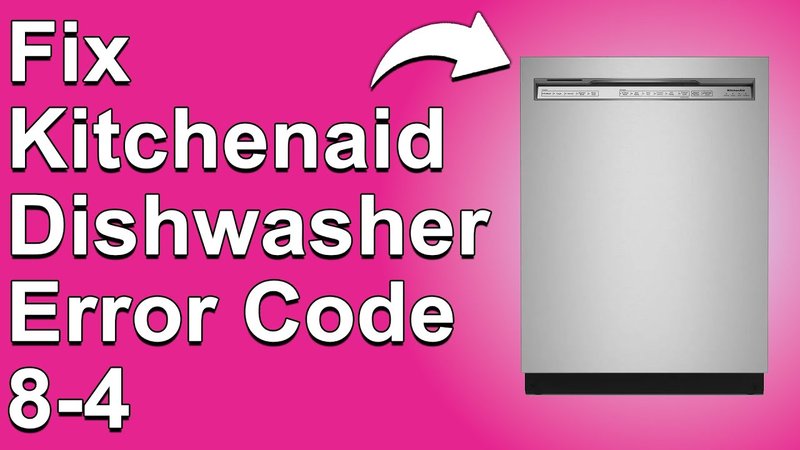
When a dishwasher is leaking, it’s like a tiny, persistent drip on your kitchen floor. It might be barely noticeable at first, but over time it can cause bigger issues, similar to how a small leak in the roof can eventually lead to a bigger repair if ignored. The trouble with leaks is that they’re often hidden, only making themselves known when things start to malfunction. The “LE” code is the dishwasher’s way of alerting you to these sneaky leaks before they get completely out of hand. By learning a bit about what causes this error and how to address it, you can keep your dishwasher running smoothly.
Understanding the “LE” Error Code
The “LE” error code on a KitchenAid dishwasher is essentially a warning signal. It’s a bit like the check engine light in your car; it doesn’t tell you exactly what’s wrong but rather indicates that something needs attention. In the case of the “LE” code, it usually points to an issue with water leakage. A leak may arise from different parts of the dishwasher, such as the door gasket, the water inlet valve, or even the hoses that carry water to and from the machine. Understanding where these leaks can occur is the first step in preventing them.
Think about your dishwasher as a closed-loop system much like your home’s plumbing. Just as pipes can wear out and start to leak over time, so can the various components of your dishwasher. The door gasket, for instance, is the soft, rubbery seal that keeps water from escaping while the dishwasher is running. If this gasket gets worn out or misaligned, water can seep out, triggering the “LE” error. Similarly, a failing water inlet valve is like a clogged faucet that doesn’t let water flow correctly, which can also lead to leaks.
Now, you might be wondering, “Is there a way to predict or stop these issues before they start?” Absolutely! Regularly inspecting these components and maintaining your dishwasher is key. Just like you might regularly check your car’s oil or tire pressure to prevent problems, giving a little TLC to your dishwasher can work wonders in preventing the “LE” error.
Regular Maintenance and Inspection
To keep your KitchenAid dishwasher from flashing the “LE” error and spoiling your dishwashing routine, regular maintenance is essential. Think of it like giving your dishwasher a wellness check-up. You wouldn’t skip your annual doctor’s visit, right? The same goes for your appliances. By checking certain parts of your dishwasher regularly, you can prevent leaks before they happen.
Start by inspecting the door gasket for any signs of wear and tear. Look for cracks, tears, or any areas where the seal is not snug. If there’s a problem, replacing the gasket is a simple fix that can prevent leaks. Next, check the water inlet valve. Ensure it’s not blocked or malfunctioning, as this could lead to water entering the machine at a higher rate than it can handle, causing a leak. A clean valve means water can flow properly, just like clearing a clogged sink.
Additionally, look at the hoses and connections. Much like garden hoses, if these are kinked or damaged, they won’t transport water effectively. This can lead to leaks both inside and outside of the dishwasher. If any hoses appear to be damaged, replacing them sooner rather than later can prevent bigger problems—and messes—down the road.
Preventative Tips for Long-Term Use
Now that we’ve talked about identifying and addressing immediate concerns, let’s look at some preventative tips to keep your dishwasher running smoothly in the long run. It’s like creating a care plan for your dishwasher to ensure it’s always in tip-top shape. With a little routine maintenance, you can extend the life of your appliance significantly.
Firstly, always use the right detergent. Using too much or the wrong type of detergent can create excess suds, which may lead to leaks and ultimately cause the “LE” code. Stick with detergents recommended by KitchenAid, ensuring they’re designed to work effectively with your specific model. It’s similar to using the right fuel for your car—not just any brand will do if you want peak performance.
Secondly, consider running your dishwasher at least once a week, even if it’s not full. This might sound counterintuitive if you’re trying to save water, but it keeps the seals and hoses from drying out, reducing the chance of cracks and leaks. It’s much like taking your car for a drive every so often, even if you’re not going far.
Lastly, occasionally check the filters and remove any food particles or debris. Clogs can cause water to back up inside the machine, leading to potential leaks. Keeping the filters clean ensures that water flows properly and is drained efficiently, preventing unnecessary wear and tear.
Preventing the “LE” error code on your KitchenAid dishwasher is all about understanding the potential causes of leaks and maintaining those parts regularly. By thinking of your dishwasher like any other essential appliance—worthy of routine checks and care—you can avoid headaches and keep it running smoothly. Regular inspection, use of proper detergents, and occasional checks of your dishwasher’s components all contribute to a leak-free experience. Remember, a little proactive care goes a long way in preventing mishaps and extending the life of your trusty kitchen companion!